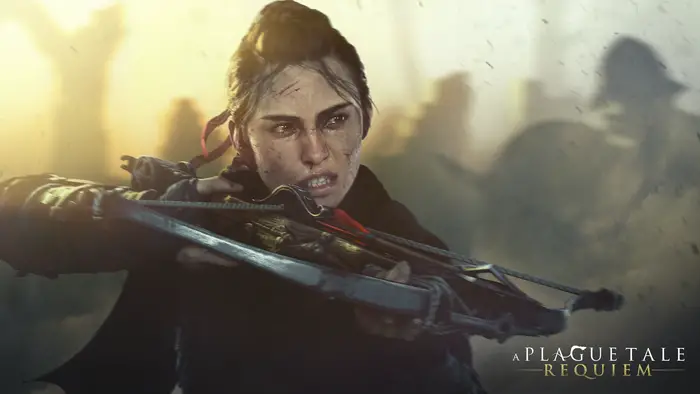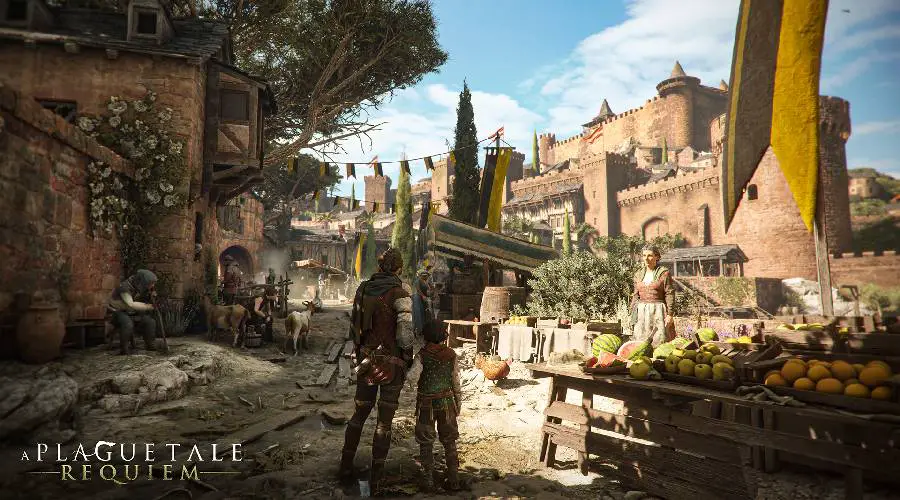Spoilers for the entirety of the game A Plague Tale: Requiem.
The sequel to the critically acclaimed A Plague Tale: Innocence has been eagerly anticipated by many players since the game play reveal trailer posted on 10 December 2021. A Plague Tale: Requiem released on 17 October 2022 by publisher Focus Entertainment and developed by Asobo Studio. After genuinely crying during the end chapter of this fantastic game; let’s look at the game after a full play-through.
A Plague Tale: Requiem’s game play
Sprinting, stealth, and scuffles, A Plague Tale: Requiem had noticeable variety in its game play mechanics. I enjoy games with different ways to advance the narrative. Amicia’s skills can be developed in three categories: prudence, aggressive, and opportunism. There is some choice and different character builds to explore. Considering what skills I wanted Amicia to develop is an upgrade to the game play in the previous game. Including more sprinting scenes was a welcome addition as well, to break up the previous formula of mostly stealth and opportunity. Sprinting ‘backwards’ came as an easier mechanic without any need to worry about direction and turning – and I was still panicked.

The easiest difficulty setting felt slightly easier than the previous game, and I think it makes the entire game more accessible. I didn’t feel the need to look up guides to finish, and there was enough trial and error for the difficulty mode to not feel tedious. A Plague Tale: Requiem provided enough opportunities for resources and upgrading. I could have grafted harder for more resources and upgrades, but at the end of the game I had a fully upgraded crossbow and one or two out of three upgrades complete for each section.
My only gripe with the game, if at all, came with the scene that comes after seeing Basilius. The rats are basically biting at Amicia and Hugo’s ankles, and I seemed to struggle turning properly while running up those steps. I got stuck many times until I plugged in a controller. Not the worst issue to have, but not everyone will have a controller lying around.
Graphics and visual design

A Plague Tale: Innocence was a visually stunning game, and its sequel is no different. From character design, clothing choices, background design and colour grading in different situations throughout the game; I was awestruck again at how a game can be so breathtaking.
The soundtrack of A Plague Tale: Requiem
A Plague Tale: Requiem’s soundtrack was composed by Olivier Deriviere. He shared some interesting information about the main theme over on Twitter. The theme seamlessly shifts from the end of A Plague Tale: Innocence to its sequel, signifying Amicia’s trauma and wrath that has developed as a result of what she has been through.

It was kept for the starting of A Plague Tale: Requiem, as Amicia thought her wrath had subsided after the end of her struggles in the first game, and her family went into a quiet period of 6 months. However, her wrath and anger will always be there, and Amicia’s wrath reaches its crescendo and feeds into Hugo’s ultimate destruction as he gives into his curse and the Macula.
Expertly crafted, the soundtrack settles the atmosphere into something that is firmly medieval and fantastical. I was reminded of something similar to The Witcher 3: Wild Hunt, and this fit in really well as a game set in the mid 1300s. The creepy factor was really well executed – terrifyingly so. The waves and seas of rats that poured into each scene brought on some pretty realistic anxiety, and the string instruments associated with the rats and any terror they brought was quite literally skin crawling.
Story and themes in A Plague Tale: Requiem
A deeper emotional bond to Hugo in this game was important to establish with the player. The introduction to Requiem helped develop a deeper bond with the character by playing ‘King and Captain’ with him and engaging with the player’s ‘inner child’. I genuinely smiled during these scenes before the pin dropped and they were in danger again.
The duality of Hugo’s character in Plague Tale: Innocence and Plague: Tale: Requiem was effective in showing his personal growth. In Requiem, Hugo’s trauma forced him to grow up insanely quickly, and he was insightful about his curse and its negative effect on the world around him. In Plague Tale: Innocence, I found Hugo to be whiny and annoying. Of course a small child raised in practical isolation from the outside world would be irritating to be around, but it did affect my game play. Sneaking around and surviving would have been much easier without him holding onto Amicia. She could have escaped onto a better life without him, and left the issue of the Prima Macula behind.
However, that would go against the foundation for a theme I really felt throughout Requiem’s story: family. Whether it was Amicia and Hugo’s biological – or found family (Lucas, Sophia, Arnaud) – they played an important role in the main characters’ survival and success. When Beatrice is sacrificed by the Countess, and Hugo thinks that Amicia is dead, the poor child thinks he’s lost both his actual mother and his symbolic mother. Hugo giving in to the Macula and passing the last threshold means that Amicia has lost the remainder of her original family, and the very thing she fought through intense struggle to save.
Ignoring her physical injuries and psychological trauma, the plot of Requiem really asserts that Amicia’s goal is to save her brother. However, this would be what lead to Hugo’s increasing trauma and arguably more horrific death after he gave into the last threshold. In fact, if they had hidden away somewhere quiet and accepted Hugo’s impending death, they could have avoided the destruction of La Cuna and Marseilles. Amicia’s need to keep her family intact lead to the death of Beatrice and Arnaud, and the consequent sacrificing of Hugo. Everything she went through and fought for was absolutely futile. This ultimate uselessness was incredibly heartbreaking, and I definitely shed some tears facing the death of what had become my little brother after the long in game hours.
The story and characters were just as fantastic as A Plague Tale: Innocence, and I would say it was even better than the first game. I was devastated at the end of my game play, and I was grasping for any kind of closure past the sound of the stone flinging from Amicia’s sling. (Luckily, we were blessed with a brighter post-credits scene that brought an overall more hopeful message after the death of Hugo and the giving in to the futility of his situation).
Overall
A Plague Tale: Requiem is a visually stunning game with a story that will probably still make me cry the next time I play through. Asobo Studio crafted a near perfect experience that just slightly outshines the first game.
Images via Asobo Studio
Have strong thoughts about this piece you need to share? Or maybe there’s something else on your mind you’re wanting to talk about with fellow Fandomentals? Head on over to our Community server to join in the conversation!

